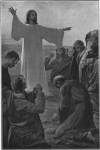From Matthew 1-4
The gospel according to Matthew begins with a genealogy. Genealogies might not mean much to people today. But they were quite important to the Jews in the first century.
This post is part of my bible in a year series.
Passage and Comments
The genealogy records Jesus Christ’s lineage.
1 The book of the genealogy of Jesus Christ, the son of David, the son of Abraham. (Mt 1:1)
The introduction of the genealogy links Jesus to David and Abraham.
“For many cultures ancient and modern, and certainly in the Jewish world of Matthew’s day, this genealogy was the equivalent of a roll of drums, a fanfare of trumpets, and a town crier calling for attention. Any first-century Jew would find this family tree both impressive and compelling. Like a great procession coming down a city street, we watch the figures at the front, and the ones in the middle, but all eyes are waiting for the one who comes in the position of greatest honour, right at the end.” (Wright, T. (2004). Matthew for Everyone, Part 1: Chapters 1-15 (p. 2). London: Society for Promoting Christian Knowledge.)
2 Abraham was the father of Isaac, and
Isaac the father of Jacob, and
Jacob the father of Judah and his brothers, 3 and
Judah the father of Perez and Zerah by Tamar, and
Perez the father of Hezron, and
Hezron the father of Ram, 4 and
Ram the father of Amminadab, and
Amminadab the father of Nahshon, and
Nahshon the father of Salmon, 5 and
Salmon the father of Boaz by Rahab, and
Boaz the father of Obed by Ruth, and
Obed the father of Jesse, 6 and
Jesse the father of David the king. (Mt 1:1–6a)
Abraham, Judah and David are very important in the genealogy. But they are not placed at the end. They are not given the most importance.
And David was the father of Solomon by the wife of Uriah, 7 and
Solomon the father of Rehoboam, and
Rehoboam the father of Abijah, and
Abijah the father of Asaph, (Mt 1:6b–7)
Solomon and Rehoboam were key kings in the line of Judah. But they are not at the end.
8 and Asaph the father of Jehoshaphat, and
Jehoshaphat the father of Joram, and
Joram the father of Uzziah, (Mt 1:8)
Jehoshaphat was faithful to the LORD. But the genealogy is not about him.
9 and Uzziah the father of Jotham, and
Jotham the father of Ahaz, and
Ahaz the father of Hezekiah, (Mt 1:9)
Hezekiah likewise had his moments. But the genealogy is not about him.
10 and Hezekiah the father of Manasseh, and
Manasseh the father of Amos, and
Amos the father of Josiah, 11 and
Josiah the father of Jechoniah and his brothers, at the time of the deportation to Babylon. (Mt 1:10–11)
Josiah is another important king in Judah’s line. But he is not the one. The genealogy is linked to another key even in Judah’s lifetime. The exile. This didn’t stop the kingly line.
12 And after the deportation to Babylon:
Jechoniah was the father of Shealtiel, and
Shealtiel the father of Zerubbabel, 13 and
Zerubbabel the father of Abiud, and
Abiud the father of Eliakim, and
Eliakim the father of Azor, 14 and
Azor the father of Zadok, and
Zadok the father of Achim, and
Achim the father of Eliud, 15 and
Eliud the father of Eleazar, and
Eleazar the father of Matthan, and
Matthan the father of Jacob, 16 and
Jacob the father of Joseph the husband of Mary, of whom Jesus was born, who is called Christ. (Mt 1:12–16)
The following line of kings is not well recorded in the Old Testament scriptures.
The last, Jesus, is called the Christ. He is given the most importance and significant in the genealogy.
It says Jesus was not begotten of natural generation. Note v. 16, “Mary, of whom was born Jesus.” A feminine form for the word “born” being used, indicates that Jesus was born of Mary, not of man. (Brooks, K. (2009). Summarized Bible: Complete Summary of the New Testament (p. 7). Bellingham, WA: Logos Bible Software.)
17 So all the generations from Abraham to David were fourteen generations, and from David to the deportation to Babylon fourteen generations, and from the deportation to Babylon to the Christ fourteen generations. (Mt 1:17)
The final summary statement links it all together. Abraham, David, Babylon and Christ. The stages in time are neatly separated into fourteen generations. This is probably not accurate, but reflects a series of seven generation divisions. A number of significance for the Jews. Representing completeness.
About Jesus
“Matthew’s gospel has stood at the front of the New Testament since very early times. Millions of Christians have read this genealogy as the beginning of their own exploration of who Jesus was and is. Once we understand what it all means, we are ready to proceed with the story. This, Matthew is saying, is both the fulfilment of two millennia of God’s promises and purposes and something quite new and different. God still works like that today: keeping his promises, acting in character, and yet always ready with surprises for those who learn to trust him.” (Wright, T. (2004). Matthew for Everyone, Part 1: Chapters 1-15 (p. 4). London: Society for Promoting Christian Knowledge.)
Copyright © Joshua Washington and thescripturesays, 2015. All Rights Reserved.


